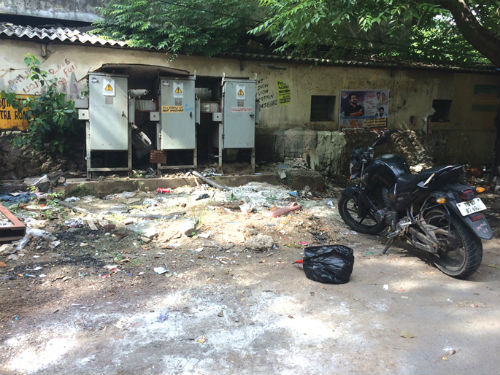Registered with the Registrar of Newspapers for India under R.N.I 53640/91
Vol. XXVII No. 13, October 16-31, 2017
With pavements like these , pedestrians can only dream
by A Special Correspondent

The Pedestrian, emblematic of the common person, the aam admi as today’s popular expression goes, is the forgotten factor in public plans and amenities in our country. S/he is not central to our grandiose plans of development. India is quite satisfied being a country of contradictions in intimate co-existence. Multi-storeyed residential mansions give a grand view of India’s poverty and slums, the common man’s lot. The latter do not protest, are infinitely patients and capable of accepting everything philosophically, as if nothing has happened in fact, nothing much indeed has happened to meet their needs.
The Pedestrian is but one species of a larger genus, manifesting as bus travellers, cyclists, those who stand in queues for basic needs, and who patiently wait in hospitals for a doctor’s attention, those who sleep on pavements in mid-summer half naked, either in a state of supreme contentment or exhaustion due to hunger probably the latter and many more we see but do not notice. The government planners’ apathy institutionalises this failure to notice.
The overhead pedestrian bridge is an example of tokenism devoid of serious intent to meet a need. People are required to climb two or, at times, three flights to reach the overhead walking path to the other side of the road. Many do not want to undertake this strenuous way of crossing the road when s/he could run across, preferring the risk of being run over to the strain of mounting and dismounting 50-60 steps under the Chennai sun! An elevator or an escalator would have cost more, but the pedestrian is not entitled to such a luxury.



Subways needing fewer steps to go down and climb up are more pedestrian-friendly than FOBs (Foot Over-Bridges) provided they are broad and well-lit. They could even provide small shopping kiosks that could be shifted from the roadside to relieve the congestion on whatever pavements these are.
Plans for subways have run into problems of shifting water mains and telephone and power cables. After encountering many time-consuming obstacles, Government has concluded that FOBs are a more practical and quicker option. It has at least begun thinking of escalators and ramps. In that process, several months have been lost and it will now take several more to complete the five FOB ‘projects’ that are on the anvil. These relatively simple installations that lend themselves to assembly like a Meccano set are pompously referred to as ‘projects’ and will materialise in their own good time.
Failing to provide for likely obstacles and the long gestation periods continue to delay installation of even simple facilities, thereby testing the patience of the Pedestrian. Meanwhile, s/he makes do with what little is available.
Take our roads and streets. Any road, any street. The pavement for pedestrians is a nominal fulfilment of an obligation devoid of its spirit (see photographs of pavement take-overs which took no searching, for they are there everywhere). Concrete slabs with rough edges telescoping into each other, one-foot high platforms meant for athletes and not for women and aged people to climb onto to escape from whizzing motor cycles and platform-hugging cars, deep ditches, uncovered sewerage lines and uncollected garbage all on the pavements, add to the day’s excitement in the life of a pedestrian. Unauthorised shops and vendors and mobile food counters occupy more space. In many roads, omnibuses are parked on pavements at night with, it is said, the connivance of the local police.
Residents showed pictures, some time ago, to the Commissioner of the Corporation of Madras, how a wide street – Kalakshetra Road – had, through misuse of public space, been effectively reduced almost to a limited path in the middle for motorised vehicles, leaving struggling pedestrians to hop-step-and-jump through this mayhem.
Pavement misuse has become a part of Chennai’s daily life. Action is awaited everywhere to change this. But it’s a never-ending wait.

